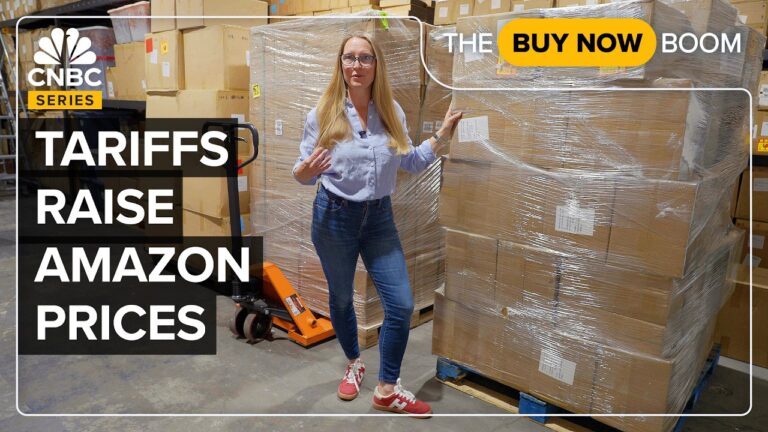Video at the bottom!
In a small warehouse in Northern California, Dusty Kenney prepares to sell her products on Amazon, which include baby spoons, placemats, bento boxes, bowls, plates, and cups, all manufactured in China. Recently, she has been confronted with a significant challenge: a steep 125% tariff on goods imported from China, which compounds the costs associated with her existing inventory of tens of thousands of products. Kenney expresses concern that these tariffs could jeopardize her business and swallow hard-earned profits.
The tariffs were announced following former President Trump’s declaration of a 10% baseline tariff on nearly all U.S. imports, along with even higher rates on various countries, particularly China. Kenney notes that while she strives to keep prices low for her customers, absorbing these additional costs is becoming increasingly untenable. The initial announcement of tariffs prompted fears in the market, leading to a drop in stock prices as businesses braced for rising costs and diminished consumer spending.
Many sellers, like Kenney, are heavily reliant on Chinese manufacturing due to the established infrastructure and lower production costs. However, the rapid increase in tariffs has forced them to contemplate moving their operations elsewhere. Companies like Portable Winch Co, which had long enjoyed duty-free shipping by producing goods in Canada, are now considering shifting their focus to markets in Europe.
The new tariff regime has affected a wide array of businesses. With estimates suggesting that 60-70% of goods sold on Amazon originate in China, the implications for pricing are significant. Many Amazon sellers fear that if they increase prices to accommodate higher tariff costs, they will struggle to compete against cheaper alternatives being offered by their international competitors.
During Trump’s presidency, tariffs were substantially raised, prompting some companies to relocate their manufacturing bases to Vietnam, Mexico, and even India. However, despite this movement, Kenney and many others express doubt that producing goods in the U.S. is financially viable given the high costs involved. This is especially true as many American manufacturers are struggling to meet the demands for lower-priced products, often relying on cheaper labor overseas to maintain a competitive edge.
Retailers like Jay Foreman, who operates Basic Fun, noted that while toy manufacturing has shifted from China to countries like Vietnam and India, many of those factories are still owned by Chinese companies. This complicated reality reveals the intertwined nature of global supply chains, making it difficult for American businesses to completely distance themselves from Chinese production.
The tariffs have also led to a rise in the prices of certain consumer goods, notably toys and more specialized products. Businesses striving for quality assurance find themselves at a disadvantage compared to companies that can ship smaller orders without incurring tariffs, which complicates their pricing strategies.
For small businesses, especially those focused on e-commerce, the heightened tariffs create an environment of uncertainty. Many have expressed a desire for clear and consistent regulations to aid in planning their operations and financial strategies. The elimination of the “de minimis” loophole, which allowed small shipments under $800 to bypass tariffs, is expected to further impact selections for both sellers and consumers, particularly those competing with platforms like Temu.
As the situation continues to evolve, American businesses are left grappling with how to adjust to a landscape marked by fluctuating tariffs and increased operational costs. The ambiguity surrounding future tariff regulations complicates decisions for business owners and consumers alike, highlighting the ongoing challenges in navigating international trade.


